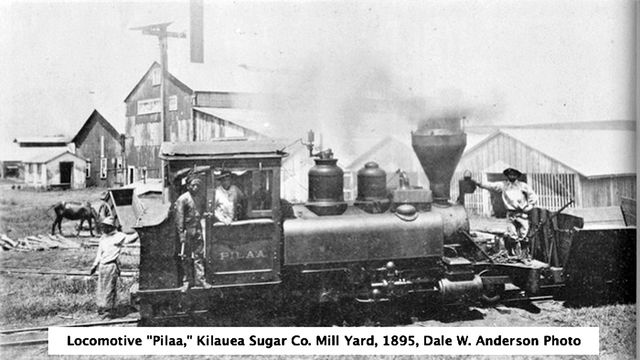Kilauea Sugar Plantation Co., which was in operation at Kilauea, Kauai, from 1880 to 1971, was the first of several Kauai sugar plantations to build and operate railroads to replace draught animals hauling sugarcane from its fields to its mill.
Its initial order of railroad equipment, manufactured by John Fowler & Co., of Leeds, England, arrived at Honolulu aboard “The City of Glasgow” from Glasgow, Scotland on Aug. 27, 1881.
Shipped to Kauai shortly thereafter, the Fowler railroad shipment included 4,248 railroad ties, tons of coal, small lots of merchandise, iron and hardware, railroad tracks, curves and switches, and a small 24-inch gauge locomotive — Fowler 4085.
Under the direction of C. V. Houseman, work commenced at Kilauea to install a railroad, and on Sept., 24, 1881, Princess Liliuokalani, who would be crowned Queen Liliuokalani in 1891, visited Kilauea Sugar Plantation Co. to drive the first spike into its first section of railroad track.
By the end of November, 3 miles of railway had been installed and the mill at Kilauea began grinding sugarcane fed by Fowler locomotive 4085 hauling cane cars loaded with sugarcane taken from distant fields.
In 1882, Kilauea plantation acquired another locomotive, Hohenzollern 284, built in Dusseldorf, Germany, which was named “Kilauea.”
Baldwin Locomotive Works of Pennsylvania locomotives “Pilaa” and “Kahili” were added to the plantation’s railroad plant in 1894 and 1902, respectively, and in 1910, Kilauea’s railroad system was comprised of 12 ½ miles of permanent track, 5 miles of portable track, 200 cane cars, six sugar cars and four locomotives.
Also of note were the 3 miles of track that connected the Kilauea mill with Kahili Landing, where bagged, milled sugar was delivered to steamers by means of a cable device.
Kahili Landing and its railroad track was abandoned beginning in 1928, when sugar from the mill was trucked to Ahukini Landing instead, and by the spring of 1942, trucks had replaced railroad locomotives and cane cars as the means of hauling sugarcane to the Kilauea mill.






very interesting, i knew my relative had been involved bringing the rail road to he Island I knew that King Kalajaua whom I must assume was father to the princess, had visited the Dreghorn estate of Robert Andrew Macfie senior and had planted some trees on the estate
but as Robert jr ended up in a bit of hot water over the Sugar plantation operation there was not much details in the family records so these articles are very very nice, it provides me with a bit more information thank you for writing them